#Biofloc Fish Farming
Text
How Pond Liners Play Vital Role in Semi Biofloc Fish Culture.
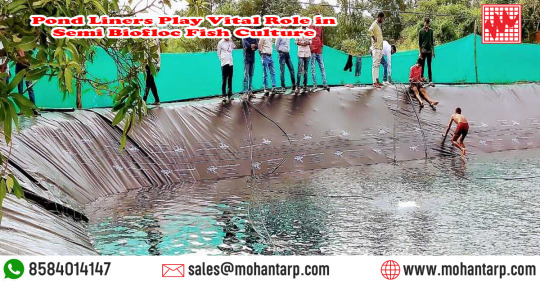
Biofloc Technology (BFT) a hybrid approach that integrates biofloc technology with traditional aquaculture practices. It improved water quality and waste recycling, while maintaining the operational simplicity of traditional pond culture. The important points to remember are as follows:
Water Management:
Pond liners prevent water and nutrients from seeping into the soil. By isolating the water body from the surrounding soil, liners help in creating a more stable environment for the fish to grow better and healthier.
2. Efficiency in Waste Recycling:
Regular water exchange is often necessary to manage waste and water quality for the hygiene of the pond.
3. Disease Control:
Separation of soil and water helps in maintaining a healthier and more controlled environment for the fish.
4. Infrastructure and Operational Efficiency:
High-quality pond liners are resistant to physical damage, UV radiation, and chemical degradation, ensuring long-term reliability for the culturist and save the time and money for the farmers.
5. Environmental Impact:
Pond liner helps the region which face water deficiency. In semi biofloc fish culture, pond liner significantly improves the functional efficiency, sustainability of the environment to improve fish health and productivity.
6. Temperature Regulation:
Liners can play a vital role in temperature regulation. It can help maintain a more stable water temperature, conducive to the growth of fish and beneficial microbes.
7. Improved Harvesting:
The liner creates a uniform surface that can be quickly drained and cleaned, reducing stress on the fish during harvest and minimizing losses.
Pond liners plays a crucial role in semi biofloc fish culture systems, providing several benefits that increase the sustainability and productivity of the operation.
How Mohan Merchandise Involved with…
For the last few years, we provide semi biofloc pond liner and biofloc fish tanks in all over India. We provide Industry best and quality material to fulfil the expectation of the farmers to grow the fish culture in India.
As per PMSY (Pradhan Mantri Matsya Sampada Yojana) we have supplied more than 200 + semi biofloc pond liners and 10000 + biofloc fish tank installed and running successfully all over India.
We have our own manufacturing unit at Howrah, West Bengal, India to provide best quality tarpaulin biofloc fish tank and semi biofloc liner. We also provide accessories related to biofloc liner and tanks. We have our own highly qualified and technically sound installation team.
More for details read our latest blogs-
https://www.mohantarp.com/biofloc-technology-an-overview/
https://www.mohantarp.com/pond-liner-for-water-harvesting/
0 notes
Text
Bioflok maintains healthy water quality for Biofloc Fish Farming. Our Biofloc Technology Microbial Formulation degrades organic sludge and lowers ammonia.
Bioflok maintains healthy water quality for Biofloc Fish Farming. Our Biofloc Technology Microbial Formulation degrades organic sludge and lowers ammonia.

0 notes
Text
कार्प मछली पालन करना होता है बेहद आसान, किसानों को मिलता है बढ़िया रिटर्न
कार्प मछली पालन करना होता है बेहद आसान, किसानों को मिलता है बढ़िया रिटर्न
क्राप मछली पालन करें किसान, होगी अच्छी कमाई
Image Credit source: TV9 (फाइल फोटो)
Carp Fish Farming: मछली पालन रोजगार का एक बेहतर साधन हो सकता है, क्योंकि बदतले वक्त के साथ इसकी मांग बढ़ती जा रही है. इसलिए यह एक बेहतर उद्योग भी साबित हो रहा है. कार्प मछली पालन से किसान अच्छी कमाई कर सकते हैं. इसका उत्पादन अधिक होता है और इसका पालन करना भी आसान है.
दुनिया में अगली सदी जलीय कृ��ि की होगी. वैज्ञानिक…
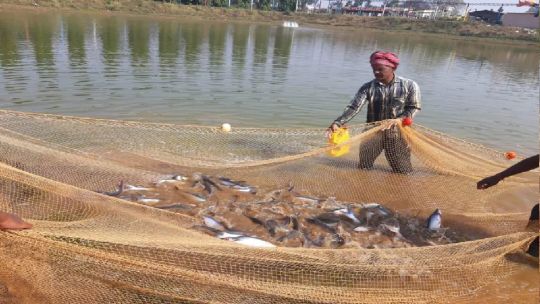
View On WordPress
0 notes
Text
जानिये PMMSY में मछली पालन से कैसे मिले लाभ ही लाभ
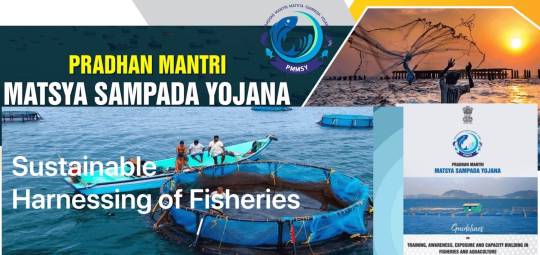
मत्स्य पालन कर PMMSY में ऐसे उठाएं 60 फीसदी सब्सिडी का लाभ
खेती किसानी में इंटीग्रेटेड फार्मिंग सिस्टम (Integrated Farming System) या एकीकृत कृषि प्रणाली के चलन को बढ़ावा देने के लिए केंद्र एवं राज्य सरकारें किसानों को परंपरागत किसानी के अलावा खेती से जुड़ी आय के अन्य विकल्पों को अपनाने के लिए प्रेरित कर रही हैं। मछली पालन भी इंटीग्रेटेड फार्मिंग सिस्टम (Integrated Farming System) का ही एक हिस्सा है।
प्रधानमंत्री मत्स्य संपदा योजना
इस प्रोत्साहन की कड़ी में प्रधानमंत्री मत्स्य संपदा योजना (Pradhan Mantri Matsya Sampada Yojana)(PMMSY) भी, किसान की आय में वृद्धि करने वाली योजनाओं में से एक योजना है। इस योजना का लाभ लेकर किसान मछली पालन की शुरुआत कर अपनी कृषि आय में इजाफा कर सकते हैं।
प्रधानमंत्री मत्स्य संपदा योजना क्या है, किस तरह किसान इस योजना का लाभ हासिल कर सकता है, इस बारे में जानिये मेरी खेती के साथ।
केंद्र और राज्य सरकार की प्राथमिकता देश के किसानों की आय में वृद्धि करने की है। खेती, मछली एवं पशु पालन के अलावा जैविक खाद आदि के लिए सरकार की ओर से कृषक मित्रों को उपकरण, सलाह, बैंक ऋण आदि की मदद प्रदान की जाती है।
किसानों की आय को बढ़ाने में मछली पालन (Fish Farming) भी अहम रोल निभा सकता है। ऐसे में आय के इस विकल्प को भी किसान अपनाएं, इसलिए सरकारों ने मछली पालन मेें किसान की मदद के लिए तमाम योजनाएं बनाई हैं।
प्रधानमंत्री मत्स्य सम्पदा योजना के शुभारम्भ अवसर पर प्रधानमंत्री का सम्बोधन
youtube
कम लागत में तगड़ा मुनाफा पक्का
मछली पालन व्यवसाय में स्थितियां अनुकूल रहने पर कम लागत में तगड़ा मुनाफा पक्का रहता है। किसान अपने खेतों में मिनी तालाब बनाकर मछली पालन के जरिए कमाई का अतिरिक्त जरिया बना सकते हैं।
मछली पालन के इच्छुक किसानों की मदद के लिए पीएम मत्स्य संपदा योजना बनाई गई है। इस योजना का लाभ लेकर किसान मछली पालन के जरिए अपनी निश्चित आय सुनिश्चित कर सकते हैं।
PMMSY के लाभ ही लाभ
पीएमएमएसवाय (PMMSY) यानी प्रधानमंत्री मत्स्य संपदा योजना में किसानों के लिए फायदे ही फायदे हैं।
सबसे बड़ा फायदा ये है कि, इसमें पात्र किसानों को योजना में सब्सिडी प्रदान की जाती है। सब्सिडी मिलने से योजना से जुड़ने वाले पर धन की उपलब्धता का बोझ कम हो जाता है।
खास तौर पर अनुसूचित जाति से जुड़े हितग्राही को अधिक सब्सिडी प्रदान की जाती है। इस वर्ग के महिला और पुरुष किसान हितग्राही को PMMSY के तहत 60 फीसदी तक की सब्सिडी प्रदान की जाती है।
प्रधानमंत्री मत्स्य संपदा योजना से जुड़ने वाले अन्य वर्ग के किसानों के लिए 40 फीसदी सब्सिडी का प्रबंध किया गया है।
प्रधानमंत्री मत्स्य संपदा योजना लोन, वो भी प्रशिक्षण के साथ
प्रधानमंत्री मत्स्य संपदा योजना के तहत मछली पालन की शुरुआत करने वाले किसानों को सब्सिडी के लाभ के साथ ही मत्स्य पालन के बारे में प्रशिक्षित भी किया जाता है। अनुभवी प्रशिक्षक योजना के हितग्राहियों को पालन योग्य मुफाकारी मछली की प्रजाति, मत्स्य पालन के तरीकों, बाजार की उपलब्धता आदि के बारे में प्रशिक्षित करते हैं।
कैसे जुड़ें PMMSY योजना से
प्रधानमंत्री मत्स्य संपदा योजना के तहत लाभ लेने के इच्छुक किसान मित्र पीएम किसान योजना की अधिकृत वेबसाइट पर आवेदन कर सकते हैं।और अधिक जानकारी के लिए, भारत सरकार की आधिकारिक वेबसाइट को देखें :भारतीय कृषि अनुसंधान परिषद के मात्स्यिकी विभागमत्स्य पालन विभाग (Department of Fisheries) - PMMSY
पीएम मत्स्य संपदा योजना के साथ किसान नाबार्ड से भी मदद जुटा सकता है। मछली पालन को बढ़ावा देने के लिए लागू पीएम मत्स्य संपदा योजना के अलावा, किसान हितग्राही को मछली पालन का व्यवसाय शुरू करने के लिए सस्ती दरों पर बैंक से लोन दिलाने में भी मदद की जाती है।
आधुनिक तकनीक से बढ़ा मुनाफा
प्रधानमंत्री मत्स्य संपदा योजना से जुड़े झारखंड के कई किसानों की आय में उल्लेखनीय रूप से सुधार हुआ है। राज्य के कई किसान इस योजना के तहत बॉयोफ्लॉक (Biofloc) और आरएएस (Recirculating aquaculture systems (RAS)) जैसी आधुनिक तकनीक अपनाकर मछली पालन से भरपूर मुनाफा कमा रहे हैं।राष्ट्रीय मात्स्यिकी विकास बोर्ड (NATIONAL FISHERIES DEVELOPMENT BOARD), भारत सरकार द्वारा जारी लेख "जलकृषि का आधुनिक प्रचलन : बायोफ्लॉक मत्स्य कृषि" की पीडीएफ फाइल डाउनलोड करने के लिये, यहां क्लिक करें - बायोफ्लॉक मत्स्य कृषि
पीएम मत्स्य संपदा योजना में किसानों को रंगीन मछली पालन के लिए भी अनुदान की मदद प्रदान की जाती है। साथ ही नाबार्ड भी टैंक या तालाब निर्माण के लिए 60 फीसदी अनुदान प्रदान करता है।
ऐसे सुनिश्चित करें मुनाफा
खेत में मछली पालन का जो कारगर तरीका इस समय प्रचलित है वह है तालाब या टैंक में मछली पालन। इन तरीकों की मदद से किसान मुख्य फसल के साथ ही मत्स्य पालन से भी कृषि आय में इजाफा कर सकते हैं।
मत्स्य पालन विशेषज्ञों के मान से 20 लाख की लागत से तैयार तालाब या टैंक से किसान बेहतरीन कमाई कर सकते हैं।ये भी पढ़ें: केमिस्ट्री करने वाला किसान इंटीग्रेटेड फार्मिंग से खेत में पैदा कर रहा मोती, कमाई में कई गुना वृद्धि!
विशेषज्ञों के अनुसार मछली पालन में अधिक कमाई के लिए किसानों को फीड आधारित मछली पालन की विधि को अपनाना चाहिए। इस तरीके से मछलियों की अच्छी बढ़त के साथ ही वजन भी बढ़िया होता है। यदि मछली की ग्रोथ और वजन बढ़िया हो तो किसान की तगड़ी कमाई भी निश्चित है।
प्रचलित मान से किसान को एक लाख रुपए के मछली के बीज पर पांच से छह गुना ज्यादा लाभ मिल सकता है।
किसान बाजार में अच्छी मांग वाली मछलियों का पालन कर भी अपनी नियमित कमाई में यथेष्ठ वृद्धि कर सकते हैं। किसानों को पंगास या मोनोसेक्स तिलापिया प्रजाति की मछलियों का पालन करने की सलाह मत्स्य पालन के विशेषज्ञों ने दी है।
Source जानिये PMMSY में मछली पालन से कैसे मिले लाभ ही लाभ
#Biofloc#Fish Farming#Integrated Farming System#matsya palan#NATIONAL FISHERIES DEVELOPMENT BOARD#PMMSY#आरएएस (Recirculating aquaculture systems (RAS))#इंटीग्रेटेड फार्मिंग सिस्टम#Youtube
0 notes
Text
Which AirOxi Aeration tube is suitable for your Aquaculture Pond
Introduction:
In fish and shrimp aquaculture, maintaining optimal oxygen levels is paramount for the health and productivity of aquatic organisms. Among the various aeration solutions available, AirOxi tubes stand out as efficient and versatile aeration diffusers for delivering oxygen to aquaculture ponds. In this comprehensive guide, we'll delve into the world of AirOxi tubes, exploring their sizes, types, and applications in various aquaculture settings.
Understanding AirOxi Tubes:
AirOxi tubes are specially designed aeration devices that utilize innovative membrane technology to efficiently dissolve oxygen into water. These tubes come in various sizes, materials, and types to suit different pond sizes and aquaculture needs. Unlike traditional aeration methods, AirOxi tubes offer superior oxygen transfer efficiency and durability, making them an ideal choice for modern aquaculture operations.
Types of AirOxi Tubes:
One of the key advantages of AirOxi tubes is their availability in a wide range of sizes to cater to different pond volumes and stocking densities. From small-scale backyard ponds to large commercial aquaculture farms, AirOxi offers tubes in sizes ranging from a few inches to several feet in length. Choosing the right size of AirOxi tube is crucial for ensuring adequate oxygen distribution throughout the pond, thereby promoting healthy aquatic life and optimal growth.
AirOxi offers a diverse range of aeration solutions tailored to meet the specific needs of various aquaculture setups. Understanding the different types of AirOxi tubes is essential for selecting the most suitable option for optimal oxygenation and water movement in your pond or tank.
Most AirOxi tubes are available in regular material and algae resistant material. The regular material is commonly used for brackish water with salinity 10 ppm and above. The algae resistant tubes are more commonly used in fresh water where algae and fungal growth is expected to be higher.
AirOxi high efficiency tube (AO125250) and Algae Resistant tube 25 mm (AO125250-AR) : These AirOxi tubes are made with special elastomeric material to get micro bubbles giving it high efficiency in oxygenation
- Oxygenation Capacity: High
- Water Movement: Medium
- Maintenance Needed: Medium
- Blower Suitable: ROOT Blower
- Recommended For: Growout ponds, nurseries

2. AirOxi low pressure tubes – regular Yellow Line and Algae resistant Green line Tubes AO125225 : These special AirOxi tubes have low wall thickness and work easily with low pressure blowers like air pump and ring blowers
- Oxygenation Capacity: High
- Water Movement: Medium
- Maintenance Needed: Low
- Blower Suitable: Ring Blower
- Recommended For: Growout ponds, nurseries, biofloc tanks

3. AirOxi Star Special Tubes for Biofloc tanks and ponds (AO-125250 Star) : This AirOxi tube is a special patented design for high water movement
- Oxygenation Capacity: High
- Water Movement: High
- Maintenance Needed: Low
- Blower Suitable: ROOT and Ring Blower
- Recommended For: Biofloc tanks
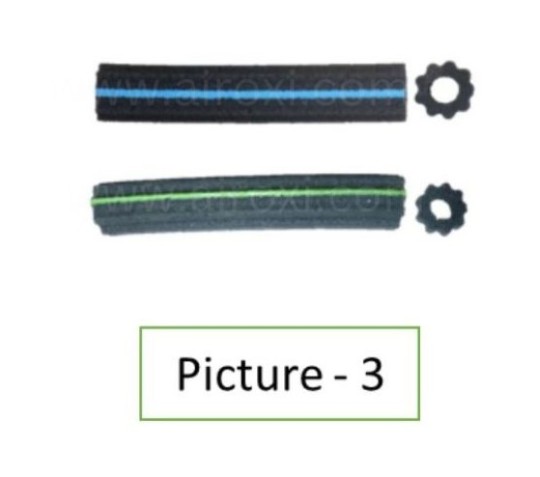
4. AirOxi Pearl - Smooth Tube for RAS (Recirculating Aquaculture Systems): This AirOxi tube is very smooth and has very fine bubbles giving very high DO levels
- Oxygenation Capacity: High
- Water Movement: Medium
- Maintenance Needed: Low
- Blower Suitable: ROOT Blower
- Recommended For: RAS setup

5. Large Diameter Tube with High Airflow (AO250380): This is one of the largest size aeration tube in the world and has a very high flow rate. Also available in algae resistant formulation
- Oxygenation Capacity: High
- Water Movement: Medium
- Maintenance Needed: Low
- Blower Suitable: ROOT Blower
- Recommended For: Biofloc ponds and tanks

6. AirOxi XTRA – This AirOxi tube is made of a different membrane material for low maintenance and low maintenance. It has large bubbles specially for biofloc tanks. This tube has a rough finish
- Oxygenation Capacity: Medium
- Water Movement: Medium
- Maintenance Needed: Low
- Blower Suitable: ROOT Blower
- Recommended For: Biofloc tanks
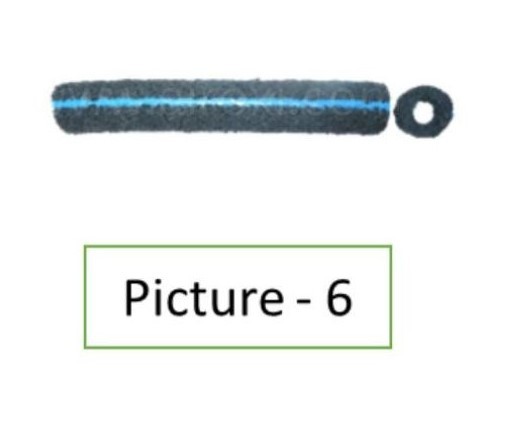
7. AirOxi 19 – This AirOxi tube is a special aeration tube made for nurseries. It has low wall thickness, needs low pressure to operate and gives high water movement needed in nurseries. It is suitable for 1-2 seasons.
- Oxygenation Capacity: Medium
- Water Movement: High
- Maintenance Needed: Low
- Blower Suitable: ROOT Blower + Ring Blower
- Recommended For: Nursery

8. AirOxi 1020 – This AirOxi tube is made for use with air pumps with a smaller inside diameter that fits with air pumps.
- Oxygenation Capacity: Low
- Water Movement: Low
- Maintenance Needed: Low
- Blower Suitable: Air pump
- Recommended For: Small tanks with air pump

9. AirOxi NC-16 – This AirOxi tube is a very thin wall, single season use tube, made of perforated food grade material. It is ideal for mud bottom ponds.
- Oxygenation Capacity: Low
- Water Movement: High
- Maintenance Needed: Low
- Blower Suitable: ROOT + Ring Blower
- Recommended For: Growout pond with mud bottom
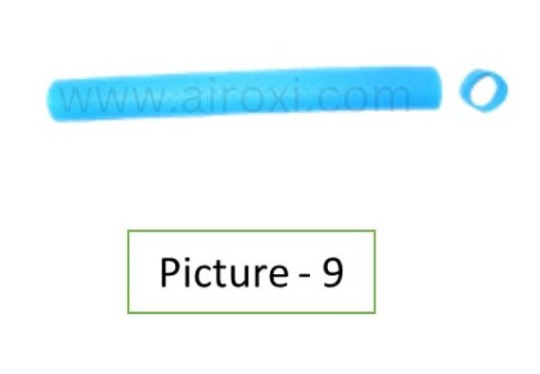
These are just a few examples of the diverse range of diffusers available to suit different aquaculture needs. Whether you're managing growout ponds, nurseries, biofloc tanks, or specialized RAS setups. You can contact us for other special diffusers that AirOxi makes.
You can also contact us for technical data sheet and more information on any of these AirOxi tubes.
Applications in Aquaculture Ponds:
AirOxi tubes find versatile applications in various aquaculture setups, including intensive shrimp farming, fish culture, and hatcheries. In shrimp farming, AirOxi tubes are used to maintain optimal oxygen levels in high-density ponds, thereby preventing oxygen depletion and ensuring healthy shrimp growth. Similarly, in fish culture operations, AirOxi tubes play a crucial role in promoting oxygenation and reducing stress among cultured fish species. Moreover, AirOxi tubes are widely utilized in hatcheries for providing oxygen-rich water to developing larvae and fry, thereby enhancing survival rates and growth.
Factors to Consider When Choosing AirOxi Tubes:
When selecting AirOxi tubes for aeration in aquaculture ponds, several factors must be taken into account. Pond size, water depth, stocking density, and the type of blower. Additionally, factors such as oxygen transfer efficiency, durability, ease of installation, and maintenance requirements should also be evaluated. By carefully assessing these factors, aquaculture operators can choose the most suitable AirOxi tubes to meet their specific needs and maximize aeration efficiency in their ponds.
Conclusion:
AirOxi tubes represent a cutting-edge solution for aeration in aquaculture ponds, offering superior oxygen transfer efficiency, durability, and versatility. By understanding the different sizes, types, and applications of AirOxi tubes, aquaculture operators can make informed decisions to optimize oxygen levels and promote the health and productivity of their aquatic organisms. As the aquaculture industry continues to evolve, AirOxi remains at the forefront of innovation, providing sustainable aeration solutions for aquaculture operations worldwide.
Contact us
+917041004098
A simple table is provided here for easy reference


#fish farming#shrimp farming#aeration solution#aquaculture#airoxi tube#airoxitube#aeration tubes#airoxi#aeration#fish
0 notes
Text
Aquatic Solutions: Addressing Global Challenges with Marine Biotechnology
Introduction to Marine Biotechnology
Marine biotechnology utilizes living marine organisms and their derivatives for industrial, medical, environmental and other sustainable applications. It focuses on exploring the immense biodiversity and biological resources found in the marine environment. The oceans cover over 70% of the Earth's surface and contain a vast variety of lifeforms that have evolved unique biological properties and molecules. Marine biotechnology aims to unlock this untapped potential through research and innovations.
Marine Bioprospecting
Marine bioprospecting involves searching oceans, coastal waters and marine life for bioactive compounds, genes and other materials that can be exploited commercially. Some key activities include monitoring biodiversity hotspots, collecting and screening biological samples for useful properties, isolating lead compounds and developing applications. Marine organisms like sponges, corals, microbes and algae have yielded molecules with diverse pharmaceutical applications. Compounds used in cancer treatments, anti-inflammatories and antimicrobials have been derived from marine sources through bioprospecting. Advances in genomics and metabolomics also aid the drug discovery process from marine natural products.
Biomedical Applications
Marine-derived pharmaceuticals represent a promising area within marine biotechnology. Several drugs developed from marine sources are already in clinical use or under clinical trials. compounds obtained from marine sponges have led to antiviral and anticancer drugs. Ziconotide, an analgesic developed from a cone snail peptide, is used for severe chronic pain. Ecteinascidin 743, an anticancer compound from a marine tunicate is marketed for treating soft tissue sarcomas and other cancers. Fucoidan from brown algae shows anti-inflammatory and anticoagulant properties. Research continues to explore more marine organisms for bioactives against diseases like arthritis and Alzheimer’s. Marine enzymes also offer opportunities in areas like tissue engineering and wound healing.
Aquaculture and Mariculture
Marine biotechnology helps improve aquaculture practices and marine farming techniques. Genetic improvements through selective breeding and biotechnology tools augment disease resistance in cultured species. Microalgae and feed supplements utilizing marine microbes aid larval and post-larval development. Bioflocs containing waste-digesting bacteria provide eco-friendly water treatment in recirculating aquaculture systems. Bioremediation using micro/macro algae assists effluent treatment from aquafarms. Marine bacterial extracts serve as immunostimulants and natural healthcare alternatives in shrimp and fish mariculture. Advances accelerate sustainable production and higher yield in mariculture to meet the global seafood demand.
Environmental Applications
Biotechnological methods help address various environmental issues affecting the oceans. Bioremediation leverages metabolically versatile marine microbes like algae, fungi and bacteria to detoxify pollutants and rehabilitate contaminated coastal and offshore sites. Phytoremediation utilizes salt-tolerant plants to remove heavy metals and nutrient runoff from seawater. Genetic engineering modifies oil-degrading bacteria to ensure faster oil spill cleanup. Biosensors incorporating marine enzymes and whole-cell detection systems enable real-time coastal pollution monitoring. Bioluminescent bacteria offer scope in marine biomonitoring as indicators of toxicity and contamination levels. Such green technologies aid responsible utilization of marine resources and their conservation.
Energy from Oceans
Marine biomass represents a renewable source of bioenergy. Micro/macroalgae can be converted to liquid biofuel through transesterification and fermentation. Seaweed cultivation coupled with pyrolysis or gasification produces biogas, while anaerobic digestion generates methane from marine biomass. Biotechnological research optimizes algal strains, development of efficient conversion processes and validation of techno-economic models to tap the ocean's energy potential viably. Microbial fuel cells leveraging exoelectrogenic marine bacteria directly convert biochemical energy to electricity. Osmotic power utilizes blue energy from salinity differences between seawater and rivers. Wave and tidal energies extracted through emerging marine hydrokinetic technologies add to the blue energy basket.
Challenges and Future Prospects
While offering immense promise, marine biotechnology market still faces challenges in areas like cost-effective production, stability of marine compounds, regulatory approvals and public acceptance of ocean-based GM technologies. Adverse impacts of climate change on marine ecosystems and dwindling natural resources also demand mitigation. Integrated efforts towards exploration of deep-sea resources, metagenomic studies on uncultured microbes, synthesis of unique marine biomolecules and developing marine-derived industrial bioprocesses can significantly advance the sector. Public-private partnerships, internationally coordinated research initiatives and responsible scientific stewardship hold the key to realizing marine biotech’s full potential sustainably in the times ahead.
In conclusion, with over 70% of our planet covered by oceans, marine biotechnology market presents a vital avenue to harness the vast treasure of marine biodiversity alongside alleviating challenges on land and seas. A blending of marine sciences with industrial biotechnology promises to deliver innovative solutions across medicine, aquaculture, bioremediation and renewable energy. Sustained efforts to develop advanced techniques, unlock marine genome secrets and scale up
0 notes
Text
To ensure maximum results in prawn and shrimp farming, incorporating advanced technologies and methodologies is essential for enhancing productivity, sustainability, and profitability. Here are 20 technologies and methods that can be pivotal in achieving these goals:
1. **Recirculating Aquaculture Systems (RAS)**: These systems recycle water, controlling environmental conditions and improving biosecurity.
2. **Biofloc Technology**: This method enhances water quality and shrimp nutrition by recycling nutrients and reducing the need for water exchange.
3. **Automated Feeding Systems**: Precision feeding through automation ensures optimal feed distribution, reducing waste and improving growth rates.
4. **Water Quality Sensors**: Real-time monitoring of water parameters (pH, oxygen levels, temperature, etc.) to ensure optimal growing conditions.
5. **Genetic Selection and Breeding**: Developing breeds with superior growth rates, disease resistance, and adaptability to different environmental conditions.
6. **Integrated Multi-Trophic Aquaculture (IMTA)**: A system that combines different species in the same farm, where the by-products of one species are utilized by another, improving sustainability.
7. **Aquaponics**: Integrating fish farming with hydroponics to grow plants, which in turn purify the water for the shrimp or prawns.
8. **Disease Management and Biosecurity Protocols**: Implementing strict biosecurity measures to prevent disease outbreaks and using probiotics to enhance the immune system of the shrimp.
9. **Precision Aquaculture**: Utilizing IoT devices and AI to analyze data and make informed decisions about feeding, harvesting, and disease management.
10. **Remote Sensing and Monitoring**: Using drones and satellite imagery to monitor ponds and environmental conditions, improving management decisions.
11. **Automated Harvesting Systems**: Reducing stress and physical damage to shrimp during the harvesting process, improving product quality.
12. **Solar-Powered Systems**: Utilizing solar energy for pumping water and powering systems, reducing energy costs and environmental impact.
13. **Algae Cultivation**: Growing algae as a natural feed supplement, improving shrimp health and reducing feed costs.
14. **Nutrient Management**: Optimizing feed composition and feeding strategies to enhance growth rates and reduce waste.
15. **Environmental Control Systems**: Controlling environmental factors within shrimp ponds or tanks, including temperature, to optimize growth conditions year-round.
16. **Smart Nets and Fencing**: Protecting shrimp from predators and preventing escapes, enhancing farm biosecurity.
17. **Sediment Management**: Implementing strategies to manage and reduce pond sediment, improving water quality and reducing the risk of disease.
18. **Waste Recycling and Management**: Converting waste products into biogas or using them as fertilizers, reducing the environmental impact.
19. **Ecosystem-Based Management**: Managing farms in a way that considers the ecological relationships and impacts on the surrounding environment.
20. **Blockchain for Traceability**: Implementing blockchain technology to enhance traceability and transparency, ensuring product quality and consumer trust.
By integrating these technologies and methods, shrimp and prawn farmers can achieve higher productivity, sustainability, and profitability, ensuring the long-term success of their aquaculture operations.

0 notes
Text
PVC / HDPE Biofloc Tank
Introducing our premium PVC / HDPE Biofloc Tank, the ideal solution for modern aquaculture and fish farming.
Key Features:
Durable Construction:
Optimal Light Penetration:
ISO & ISI Certified:
Waterproof and Weatherproof:
Tear Lock Technology:
Applications Areas:
Aquaculture Use
Fish Farming
Research and Education
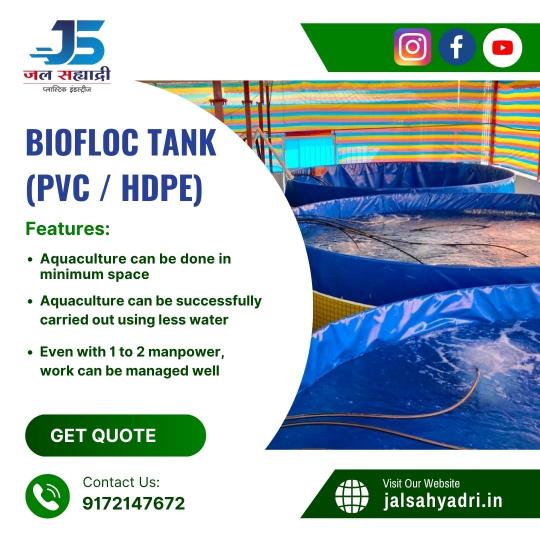
0 notes
Text

Probiotics have become indispensable in fish farming for their remarkable benefits. The best probiotics for fish farming include specific strains of beneficial bacteria and yeast. These microorganisms help maintain fish health, improve digestion, enhance disease resistance, and promote efficient nutrient utilization. Whether administered through feed, water, or biofloc systems, these probiotics contribute to sustainable aquaculture practices by reducing the need for antibiotics, improving water quality, and supporting resource efficiency. As the aquaculture industry strives for environmentally friendly and responsible practices, these probiotics play a crucial role in ensuring the well-being of farmed fish and the planet.
0 notes
Text
Biofloc Liner for Fish Farming-GreenPro Ventures
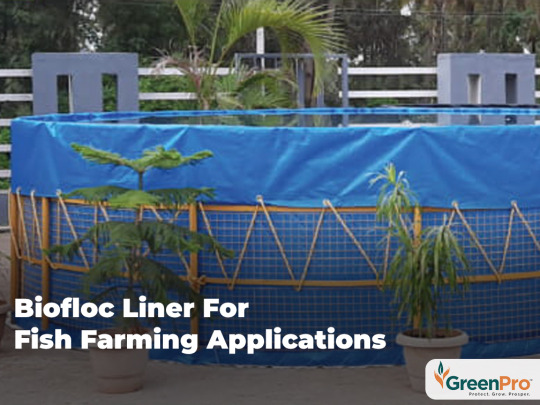
Fish Farming is an art that needs patience and understanding from the individual. Once the process of fish farming is done, there is a necessity to segregate the fish; hence, to complete the process, there is a need to have Biofloc Liners. The liners are practical and must-have products for fish farmers globally. Searching for the product in the offline market may be easy, but receiving them in quality is a question of the query. At GreenPro Ventures, we believe in the quality of the product, and hence you can visit our unit and check the quality of the product; based on that, you can book bulk orders with us at practical and affordable prices. Please connect with us to learn more about the product and the quality of the Biofloc Liner. For More Information Visit: https://www.greenproventures.com/biofloc-liner-for-fish-farming-applications/
0 notes
Text
How Pond Liners Play Vital Role in Semi Biofloc Fish Culture
Biofloc Technology (BFT) a hybrid approach that integrates biofloc technology with traditional aquaculture practices. It improved water quality and waste recycling, while maintaining the operational simplicity of traditional pond culture. The important points to remember are as follows:
Water Management:
Pond liners prevent water and nutrients from seeping into the soil. By isolating the water…
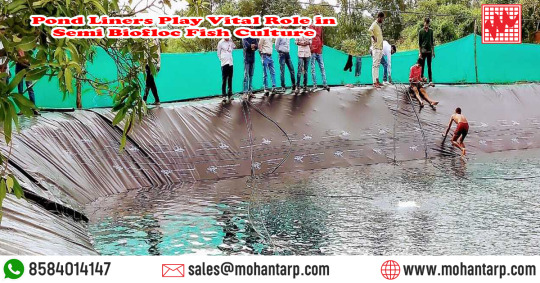
View On WordPress
0 notes
Text
Biofloc Fish Farming In Nepal
Introduction
Biofloc fish farming is gaining popularity in Nepal as an effective and long-lasting technique for growing fish. This innovative technique involves creating an environment where microorganisms, such as bacteria and algae, form a bio floc to enhance water quality and provide a nutrient-rich environment for fish. In Nepal, where traditional aquaculture faces water scarcity and environmental concerns, bio floc fish farming offers a promising solution.
Biofloc fish farming is a kind of aquaculture that uses microbial communities to turn fish waste into a naturally occurring food source, enabling high-density, sustainable fish farming.
With its diverse topography and varying climate, Nepal presents opportunities and challenges for aquaculture. Implementing bio floc technology allows fish farmers to overcome some of these challenges. One of the critical advantages of bio floc fish farming in Nepal is its water-saving feature.
Traditional aquaculture often requires large amounts of water, which can be a limitation in regions with water scarcity. Biofloc systems significantly reduce water consumption, making it a sustainable option for farmers in Nepal.
Moreover, biofloc fish farming contributes to increased biosecurity. The closed and controlled environment minimizes the risk of diseases, providing a healthier and more secure environment for fish growth. This is particularly important in Nepal, where disease outbreaks can devastate aquaculture.
Also, Read: Depths of Sustainable Fish Farming Investigated
Is Biofloc Fish Farming Profitable?
Biofloc fish farming can be very profitable, but it’s not a guaranteed path to riches. Several factors influence its potential for success.

The microbial flocs in biofloc systems provide a natural and cost-effective feed source for the fish.
The market demand for fish is another crucial factor. In Nepal, where fish is a staple food and demand is consistently high, biofloc fish farming can be lucrative. The controlled environment of biofloc systems ensures a steady supply of quality fish, meeting consumer preferences and fetching more money on the open market.
However, like any business venture, biofloc fish farming success requires careful planning, proper management, and adherence to best practices. Farmers need to invest in training and education to maximize the benefits of biofloc technology and ensure a profitable outcome.
Biofloc Fish Farming Guide
Implementing a successful biofloc fish farming system demands a thorough comprehension of the technology and its principles. Here is a step-by-step guide to help farmers in Nepal establish and manage a biofloc fish farm:
Step 1: Selection of Site: Select a place that has access to water and adequate facilities. Think about things like availability, temperature, and water quality.
Step 2: System Setup: Install a bio-floc system, including tanks or ponds, aeration systems, and a water recirculation system. Ensure proper design and sizing based on the planned fish production.
Step 3: Microbial Inoculation: Introduce beneficial microorganisms like bacteria and algae to initiate bio floc formation. This microbial community will help maintain water quality and provide a nutrient-rich environment for fish.
Step 4: Stocking the Fish: Select appropriate fish species based on market demand and local preferences. Stock the fish in the biofloc system at recommended densities.
Step 5: Water Quality Management: Monitor and manage water parameters such as pH, dissolved oxygen, ammonia, and nitrite levels. Adjust water quality as needed to ensure optimal conditions for fish growth.
Step 6: Feed Management: Implement a feeding strategy based on the nutritional requirements of the selected fish species. Use high-quality, balanced feed and adjust feeding rates based on fish growth.
Step 7: Disease Prevention: Adopt biosecurity measures to prevent disease outbreaks. Implement quarantine protocols for new fish introductions and monitor health regularly.
Step 8: Harvesting: Plan the harvesting process based on the growth rates of the fish. Use proper harvesting techniques to minimize stress and ensure product quality.
Step 9: Marketing: Develop a marketing strategy to sell the harvested fish. Establish partnerships with local markets, restaurants, or distributors to guarantee a consistent item market.
Step 10: Continuous Learning: Stay updated on advancements in biofloc technology and aquaculture best practices. Attend training programs and workshops and engage with the aquaculture community for continuous learning and improvement.
Biofloc Fish Farming Cost
While bio-floc fish farming offers numerous benefits, awareness of the setup and maintenance costs of a bio-floc system is crucial for farmers in Nepal considering this innovative method. The cost of biofloc fish farming can differ based on elements like the size of the operation, system design, and local conditions.
General range of estimated costs for Biofloc fish farming in Nepal:
Small backyard system (around 1000 liters): NPR 20,000 — NPR 50,000
Medium-scale system (around 5000 liters): NPR 50,000 — NPR 1,00,000
Large-scale commercial system (around 10,000 liters or more): NPR 1,00,000 — NPR 5,00,000 or more
Here’s a breakdown of critical expenses:
Infrastructure Costs:
Building bio floc ponds involves expenses such as excavation, pond liners, aeration systems, and other infrastructure components. The size and number of ponds will influence the overall infrastructure cost.
Microbial Inoculation:

Carbon sources, such as molasses, are often added to stimulate microbial growth in biofloc systems.
These additives contribute to developing a healthy microbial community in the pond.
For more details Click Here
0 notes
Text

Biofloc: Revolutionizing Aquaculture Practices for Improved Productivity
Aquaculture, the farming of aquatic organisms such as fish, shellfish, and crustaceans, has experienced significant advancements in recent years. Among these innovations, one practice stands out for its potential to revolutionize the industry: biofloc technology. Biofloc is a sustainable aquaculture system that utilizes the cultivation of beneficial microbial communities to improve water quality, enhance feed utilization, and boost productivity. In this article, we will explore how biofloc technology is transforming aquaculture practices and its implications for improved productivity.
Traditionally, aquaculture systems rely on water exchange or flow-through methods to maintain water quality for the cultured organisms. However, these methods often result in high water consumption and the release of excess nutrients into the environment, leading to environmental degradation. Biofloc technology offers a sustainable alternative by promoting the growth of dense microbial aggregates, or bioflocs, which actively convert excess nutrients into microbial protein. This protein-rich biomass acts as a natural feed source for the cultured organisms, reducing the dependence on external feed inputs and improving feed conversion efficiency.
One of the key advantages of biofloc technology is its ability to improve water quality. The bioflocs formed in the system efficiently trap and convert excess nutrients, such as nitrogen and phosphorus, into microbial biomass. This process, known as nutrient bioremediation, helps maintain optimal water conditions, reducing the risk of diseases and improving overall culture performance. The enhanced water quality in biofloc systems minimizes the need for water exchange, resulting in significant water savings and reducing the environmental footprint of aquaculture operations.
Biofloc technology also offers benefits in terms of disease management. The dense microbial community in biofloc systems creates a competitive environment that inhibits the growth of pathogenic bacteria and parasites. Additionally, the bioflocs themselves can act as a source of probiotics, promoting the development of a healthy gut microbiota in the cultured organisms. By minimizing the use of antibiotics and other chemicals, biofloc technology aligns with sustainable and environmentally friendly aquaculture practices.
Moreover, the presence of bioflocs in aquaculture systems enhances the nutritional profile of the cultured organisms. The microbial biomass is a rich source of proteins, lipids, vitamins, and minerals, which can supplement the feed and provide a balanced diet for the aquatic species. This leads to improved growth rates, enhanced immune response, and higher survival rates of the cultured organisms. As a result, biofloc technology not only increases productivity but also improves the overall quality of the harvested products.
The implementation of biofloc technology is flexible and adaptable to various aquaculture systems. It can be applied in both freshwater and marine environments, and it is suitable for a wide range of species, including fish, shrimp, and bivalves. The technology can be implemented in small-scale operations as well as large commercial farms, offering scalability and economic viability for aquaculturists.
In conclusion, biofloc technology is revolutionizing aquaculture practices by improving productivity, sustainability, and profitability. By harnessing the power of beneficial microbial communities, biofloc systems enhance water quality, optimize nutrient utilization, and reduce environmental impacts. The technology's disease management benefits, nutritional enhancements, and versatility make it a game-changer for the aquaculture industry. As the demand for sustainable and responsible food production continues to grow, biofloc technology is poised to play a crucial role in meeting these challenges while ensuring the future of aquaculture is prosperous and environmentally friendly.
0 notes
Text
क्या है बॉयोफ्लॉक तकनीक, जिससे आसान हुआ मछली पालन
क्या है बॉयोफ्लॉक तकनीक, जिससे आसान हुआ मछली पालन
बॉयोफ्लॉक मछली पालन में आगे आ रही महिलाएं
Image Credit source: King Fisheries
Biofloc Fish Farming: मछली पालन में नयी तकनीक के आने के बाद अब महिला किसानों का रुझान भी मछली पालन की तरफ बढ़ा है. बॉयोफ्लॉक तकनीक एक ऐसी ही तकनीक है जिसके जरिए महिलाएं भी आसानी से मछली पालन कर सकती है. इस तकनीक के इस्तेमाल से झारखंड और ओडिशा में महिलाएं मछली पाल��� कर रही है.
नई तकनीक के अविष्कार और इस्तेमाल से अब कृषि…
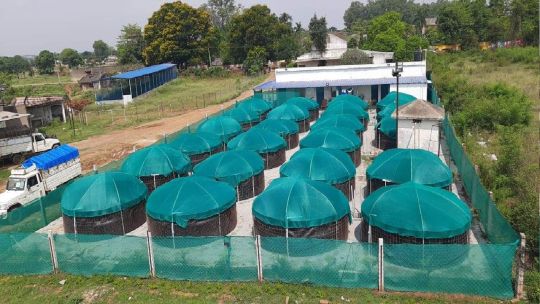
View On WordPress
0 notes
Video
youtube
আধুনিক পদ্ধতিতে মাছ চাষ -2 New Technic Of Fish Farming | Semi Biofloc Bo...
0 notes